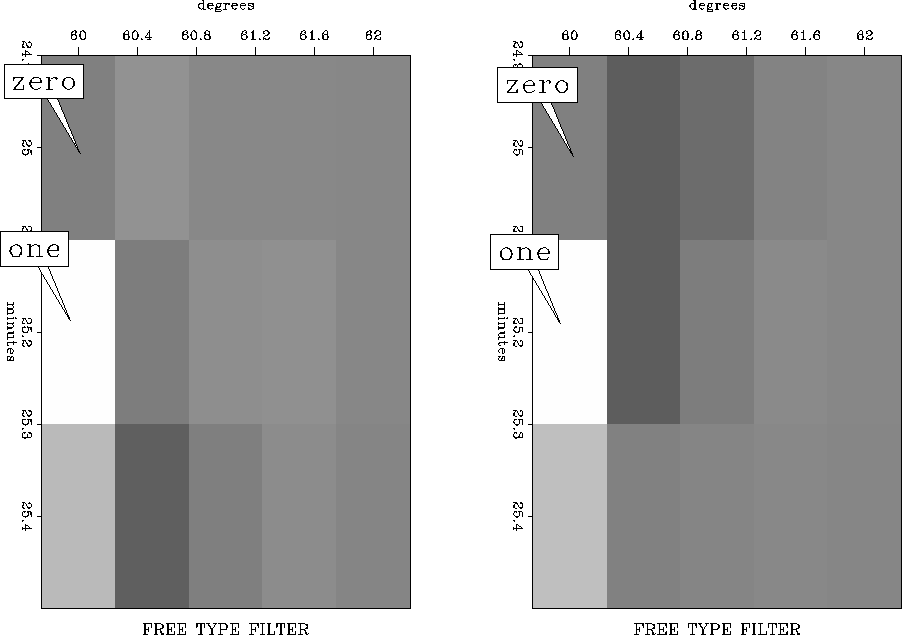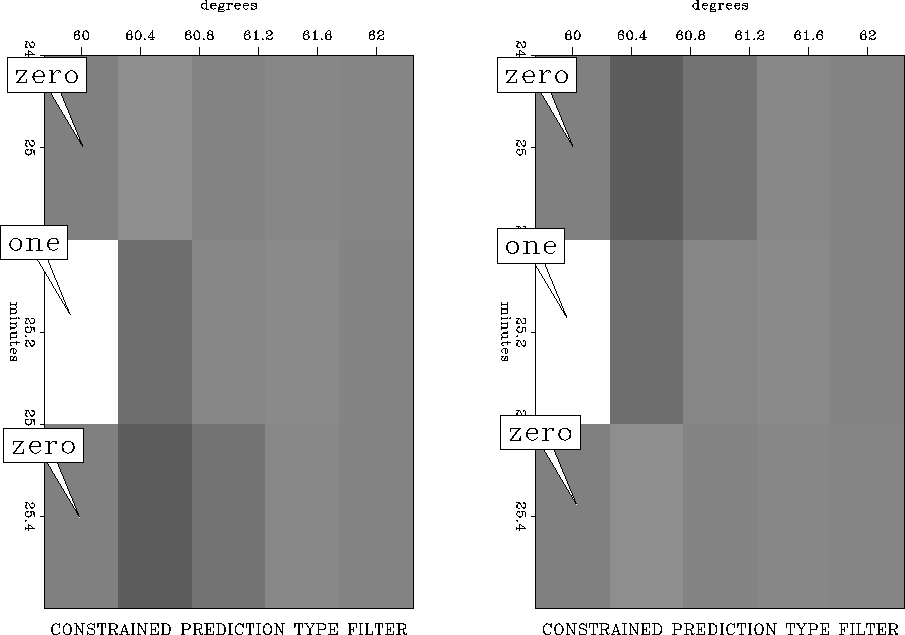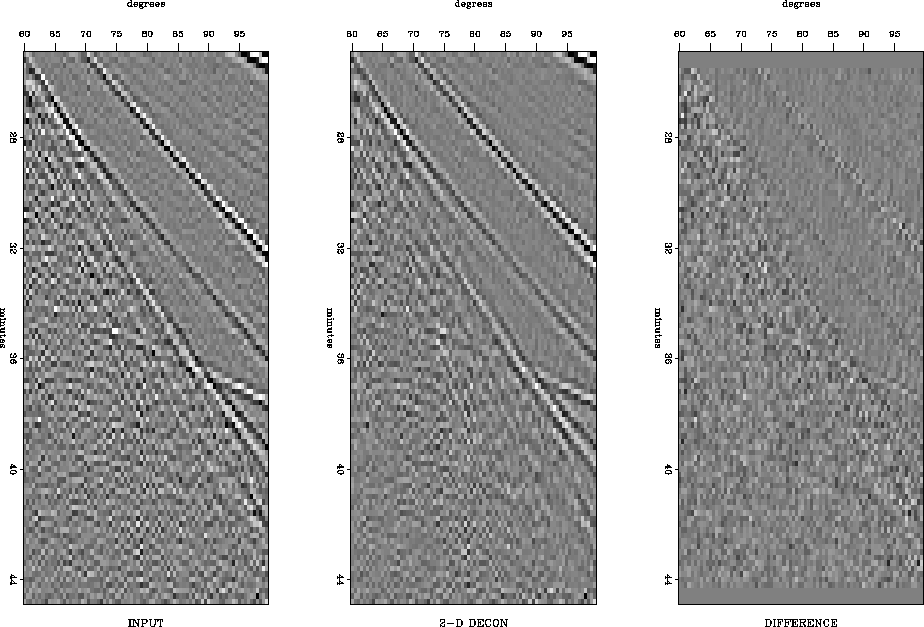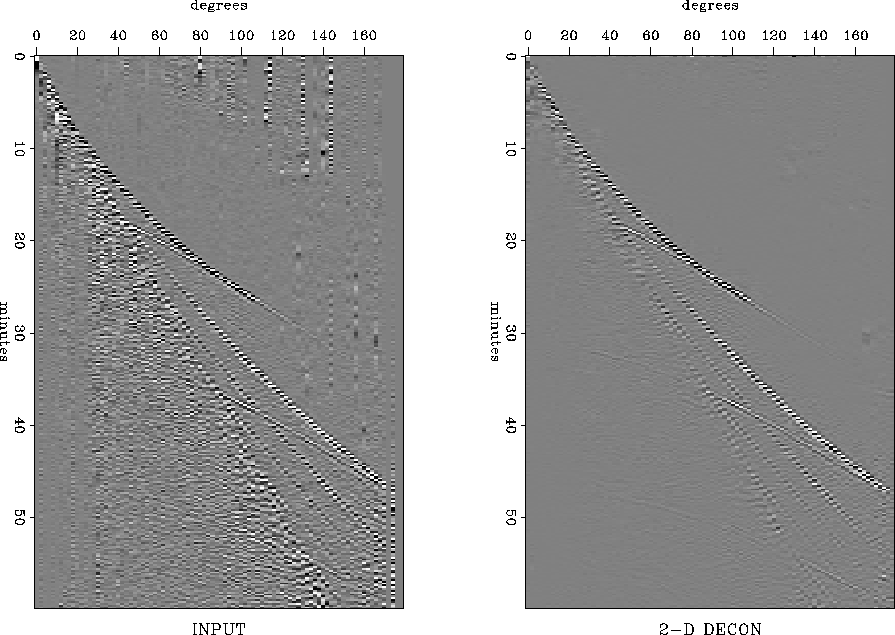




Next: OTHER APPLICATIONS OF TWO-D
Up: A LATERAL-PREDICTION FILTER APPLICATION
Previous: Filter shape considerations
The similarity in the results of applying Filter (2) and
applying FX-decon may be explained by the Fourier transform of the
FX-decon operators.
FX-decon calculates a separate filter within each frequency of the form
|  |
(3) |
If these filters were transformed from the frequency-space domain into the
time-space domain, they would appear as a single two-dimensional filter.
The collection of these filters in the frequency-space domain
 transforms to
transforms to
 in the time-space domain,
where the number of rows is the number of time samples in the
window being considered. (The subscripts are omitted for simplicity.)
The previous time-space filter is the same as Filter (2) except
for the number of rows. It might be expected that the prediction would
be limited to elements close to the center of the filter, since events
far from the output point are unlikely to affect data at the output position,
but correlations for events widely separated in time will create problems
with incorrect lineups in the output of FX-decon.
in the time-space domain,
where the number of rows is the number of time samples in the
window being considered. (The subscripts are omitted for simplicity.)
The previous time-space filter is the same as Filter (2) except
for the number of rows. It might be expected that the prediction would
be limited to elements close to the center of the filter, since events
far from the output point are unlikely to affect data at the output position,
but correlations for events widely separated in time will create problems
with incorrect lineups in the output of FX-decon.
To keep the calculation and application of the filters symmetrical,
the two-dimensional deconvolution examples shown in this paper have
two filters calculated and applied within each window: one
forward in space
and one reversed. The filters are not extended beyond times where
a full filter response is available, so the two-dimensional deconvolution
results shown here have the original data at the top and bottom of
the section.
For the type operator shown in Filter (1),
the filter calculated for the forward prediction was
|  |
(4) |
and for the reverse prediction, the filter calculated was
|  |
(5) |
For simplicity, I will refer to this type of filter, with free coefficients
in the output column, as the a11-free filter.
For a filter of the type shown in Filter (2),
the filter calculated appears as
|  |
(6) |
for the forward prediction, and
|  |
(7) |
for the reverse prediction.
I will refer to this filter as the a11-constrained filter.
Notice that the forward and reverse predictions are symmetric in the
case of the a11-constrained type filter but not for the
a11-free filter.
Plots of the filters are shown in Figures 1 and 2.
lomofilt
Figure 1
A calculated a11-free filter. The left side is the forward filter,
and the right side is the reverse filter. Push the button for a movie
of the filters for each iteration of the filter design process.




 latrfilt
latrfilt
Figure 2
A calculated a11-constrained filter. The left side is the forward filter,
and the right side is the reverse filter. Push the button for a movie
of the filters for each iteration of the filter design process.





Now compare the results of the previous
two filter shapes on the data that show the greatest
difference when used with the a11-free filter and the
a11-constrained filter.
The result using the a11-constrained filter is shown in
Figure 3.
The a11-free filter
result is shown in Figure 4.
Figure 4 shows that the a11-free filter has passed
much more noise than the a11-constrained filter.
Finally, we show Shearer's full dataset in Figure 5.
The two-dimensional deconvolution filter using the a11-constrained filter
has eliminated most of the random noise
in the input section.
Examples of comparisons between FX-decon and
lateral prediction with two-dimensional deconvolution
are shown in another paper in this volume Abma (1993).
trans
Figure 3
Two-D deconvolution filtering of the horizontal component
of Shearer's global image dataset with the a11-constrained filter.




 transy
transy
Figure 4
Two-D deconvolution filtering of the horizontal component
of Shearer's global image dataset using the a11-free
filter.




 s2D
s2D
Figure 5
Two-dimensional deconvolution filtering of the horizontal component
of the full global image dataset using the a11-constrained
filter. Push the button to change the processing parameters and plot
a new version of the output.










Next: OTHER APPLICATIONS OF TWO-D
Up: A LATERAL-PREDICTION FILTER APPLICATION
Previous: Filter shape considerations
Stanford Exploration Project
11/17/1997
 transforms to
transforms to
 in the time-space domain,
where the number of rows is the number of time samples in the
window being considered. (The subscripts are omitted for simplicity.)
The previous time-space filter is the same as Filter (2) except
for the number of rows. It might be expected that the prediction would
be limited to elements close to the center of the filter, since events
far from the output point are unlikely to affect data at the output position,
but correlations for events widely separated in time will create problems
with incorrect lineups in the output of FX-decon.
in the time-space domain,
where the number of rows is the number of time samples in the
window being considered. (The subscripts are omitted for simplicity.)
The previous time-space filter is the same as Filter (2) except
for the number of rows. It might be expected that the prediction would
be limited to elements close to the center of the filter, since events
far from the output point are unlikely to affect data at the output position,
but correlations for events widely separated in time will create problems
with incorrect lineups in the output of FX-decon.








